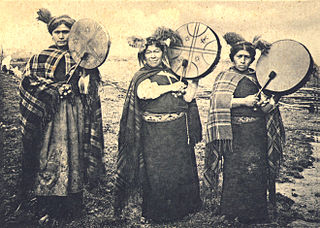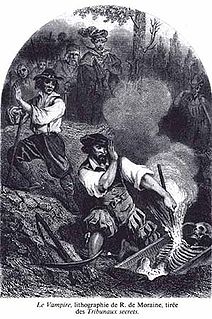
A demon is a supernatural being, typically associated with evil, prevalent historically in religion, occultism, literature, fiction, mythology, and folklore; as well as in media such as comics, video games, movies, anime, and television series.

Apep or Apophis was the ancient Egyptian deity who embodied chaos and was thus the opponent of light and Ma'at (order/truth). He appears in art as a giant serpent. His name is reconstructed by Egyptologists as *ʻAʼpāp(ī), as it was written ꜥꜣpp(y) and survived in later Coptic as ⲀⲫⲱⲫAphōph. Apep was first mentioned in the Eighth Dynasty, and he was honored in the names of the Fourteenth Dynasty king 'Apepi and of the Greater Hyksos king Apophis.

Mapuche or Mapudungun is an Araucanian language related to Huilliche spoken in south-central Chile and west central Argentina by the Mapuche people. It is also spelled Mapuzugun and Mapudungu. It was formerly known as Araucanian, the name given to the Mapuche by the Spaniards; the Mapuche avoid it as a remnant of Spanish colonialism.

The Mapuche are a group of indigenous inhabitants of present-day south-central Chile and southwestern Argentina, including parts of present-day Patagonia. The collective term refers to a wide-ranging ethnicity composed of various groups who shared a common social, religious, and economic structure, as well as a common linguistic heritage as Mapudungun speakers. Their influence once extended from Aconcagua Valley to Chiloé Archipelago and later spread eastward to Puelmapu, a land comprising part of the Argentine pampa and Patagonia. Today the collective group makes up over 80% of the indigenous peoples in Chile, and about 9% of the total Chilean population. The Mapuche are particularly concentrated in the Araucanía region. Many have migrated from rural areas to the cities of Santiago and Buenos Aires for economic opportunities.
The Deer Woman, sometimes known as the Deer Lady, is a spirit in Native American mythology who is primarily associated with fertility and love. Though primarily shown as a benign spirit, she is also shown to lure promiscuous men to their death. She appears as either a beautiful young woman or deer. The Deer Woman has equivalents in Greek Mythology and other mythologies across the world.
Kalku or Calcu, in Mapuche mythology, is a sorcerer or witch who works with black magic and negative powers or forces. The essentially benevolent shamans are more often referred to as machi, to avoid confusion with the malevolent kalku. Its origins are in Mapuche tradition.

A machi is a traditional healer and religious leader in the Mapuche culture of Chile and Argentina. Machis play significant roles in Mapuche religion. In contemporary Mapuche culture, women are more commonly machis than men but it is not a rule.

The mythology and religion of the indigenous Mapuche people of south-central Chile and southwestern Argentina is an extensive and ancient belief system. A series of unique legends and myths are common to the various groups that make up the Mapuche people. These myths tell of the creation of the world and the various deities and spirits that reside in it.
The Chilote mythology or Chilota mythology is formed by the myths, legends and beliefs of the people who live in the Chiloé Archipelago, in the south of Chile. This mythology reflects the importance of the sea in the life of Chilotes.
The legend of Trentren Vilu and Caicai Vilu is a Mapuche flood myth that tells the story of a fierce battle between two mythical snakes, Trentren Vilu and Caicai Vilu. It explains how the south of Chile came to have its accidented geography.
The Peuchen is a creature from the Mapuche mythology and Chilote mythology pertaining to southern Chile, a much feared shapeshifting creature that can instantly change into animal form.
Chilean mythology includes the mythology, beliefs and folklore of the Chilean people.
The Araucanization of Patagonia was the process of the expansion of Mapuche culture, influence, and its Mapudungun language from Araucanía across the Andes into the plains of Patagonia. Historians disagree over the time period during which the expansion took place, but estimate it occurred roughly between 1550 and 1850.
The wekufe, also known as huecufe, wekufü, watuku, huecufu, huecubo, huecubu, huecuvu, huecuve, huecovoe, giiecubu, güecubo, güecugu, uecuvu, güecufu; is an important type of harmful spirit or demon in Mapuche mythology. The word wekufe comes from the Mapudungun word wekufü meaning "demon, outside being".

Legends of vampires have existed for millennia; cultures such as the Mesopotamians, Hebrews, ancient Greeks, and Romans had tales of demonic entities and blood-drinking spirits which are considered precursors to modern vampires. Despite the occurrence of vampire-like creatures in these ancient civilizations, the folklore for the entity we know today as the vampire originates almost exclusively from early 18th-century Southeastern Europe, particularly Transylvania as verbal traditions of many ethnic groups of the region were recorded and published. In most cases, vampires are revenants of evil beings, suicide victims, or witches, but can also be created by a malevolent spirit possessing a corpse or a living person being bitten by a vampire themselves. Belief in such legends became so rife that in some areas it caused mass hysteria and even public executions of people believed to be vampires.
The Conquest of Chile is a period in Chilean historiography that starts with the arrival of Pedro de Valdivia to Chile in 1541 and ends with the death of Martín García Óñez de Loyola in the Battle of Curalaba in 1598, and the destruction of the Seven Cities in 1598–1604 in the Araucanía region.
Mapuche medicine is the system of medical treatment historically used by the Mapuche people of southern Chile. It is essentially magical-religious in nature, believing disease to be caused by supernatural factors such as spells and curable by treatments based on rituals, thermal waters and herbs. Knowledge of medicinal herbs is one of the best-known elements of Mapuche medicine and is still used today., One of the most striking aspects of historical Mapuche medicine was the use of surgery as a treatment, which was developed to treat wounds and traumas suffered in the frequent battles between tribes. Fractures and dislocations of bones were treated by immobilising and covering the limbs with pastes and ointments made of medicinal herbs. As in Europe, the practice of the bloodletting was also commonplace and used as a treatment for many conditions. In Mapuche culture, it was done by making small cuts with a very sharp stone called a "guincubue" to draw blood, then covering the cut with an astringent or herbal mix. Bloodletting was also used by parents on children to make them lighter, more agile and more capable of working and fighting, as it was thought that their blood was salty and heavy. Hygiene was very important in Mapuche life. They were very clean and tidy, bathing every day in nearby streams or rivers, regardless of weather conditions. The bark of the Quillaja tree, which is very common in the local area, was used as soap.
The Mapuche people of southern Chile and Argentina have a long history dating back as an archaeological culture to 600–500 BC. The Mapuche society had great transformations after Spanish contact in the mid–16th century. These changes included the adoption of Old World crops and animals and the onset of a rich Spanish–Mapuche trade in La Frontera and Valdivia. Despite these contacts Mapuche were never completely subjugated by the Spanish Empire. Between the 18th and 19th century Mapuche culture and people spread eastwards into the Pampas and the Patagonian plains. This vast new territory allowed Mapuche groups to control a substantial part of the salt and cattle trade in the Southern Cone.
Gualicho is a genus of theropod dinosaur. The type species is Gualicho shinyae. It lived in what is now northern Patagonia, on what was then a South American island continent split off from the supercontinent Gondwana. The fossils were found in the Huincul Formation, dating to the late Cenomanian-early Turonian age of the upper Cretaceous Period, around 93 million years ago.
The origin of the Mapuche has been a matter of research for over a century. The genetics of the Mapuche do not show overly clear affinities with any other known indigenous group in the Americas, the same goes for linguistics where Mapuche language is considered a language isolate. Archaeological evidence shows Mapuche culture has existed in Chile at least since 600 to 500 BC. Mapuches are late arrivals in their southernmost and easternmost (Pampas) areas of settlement, yet Mapuche history in the north towards Atacama Desert may be older than historic settlement suggest. The Mapuche has received significant influence from Pre-Incan (Tiwanaku?), Incan and Spanish peoples, but deep origins of the Mapuche predates these contacts. Contact and conflict with the Spanish Empire are thought by scholars such as Tom Dillehay and José Bengoa to have had a profound impact on the shaping of the Mapuche ethnicity.





